09 Jun Caesar’s 2nd Invasion Britain 54 BC (Part 4)
‘Cities and Thrones and Powers,
Stand in Time’s eye,
Almost as long as flowers,
Which daily die.
But, as new buds put forth
To glad new men,
Out of the spent and considered Earth
The Cities rise again’
–Rudyard Kipling
Introduction
This is part 4 of the historical and archaeological evidence that supports the theory that Julius Caesar’s invasions of Ancient Britain (Britannia) in 55-54 BC helped establish Celtic dynasties loyal to Rome. The political unrest between rival Celtic tribal rulers provides the backdrop of the epic historical fantasy series, Curse of Clansmen and Kings.
Below are highlights of Caesar’s second expedition after he learns that several of his ships had been damaged in a storm.
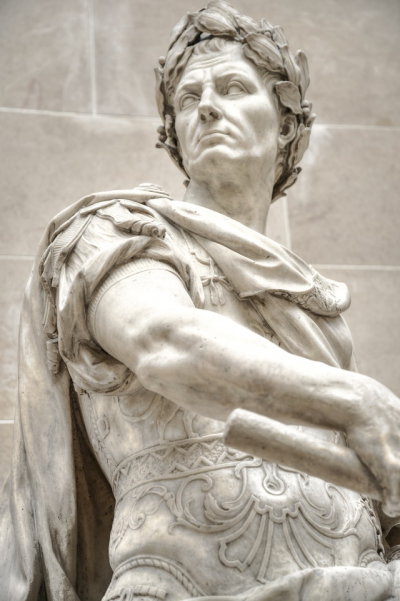
Statue of Julius Caesar Displayed at Louvre Museum
Caesar’s 2nd Invasion Britain
Purpose of the Second Expedition
In his accounts, Julius Caesar never gave a rationale for his return to Britain in 54 BC. However, it can be surmised that his single-minded march to the Thames River and from there to Essex was to barter for the return of Prince Mandubracius and to grant him sovereignty of the Trivovantes tribe. The prince had escaped to Gaul, seeking Caesar’s protection after his father had been brutally slain by Cassivellaunus—the ruler of the Catuvellauni tribe. Mandubracius was Caesar’s trump card for dividing the tribal kingdoms in their resistance to Rome. The strategy of ‘divide and conquer’ was a tactic that the Roman general had often used in his conquest of Gaul.
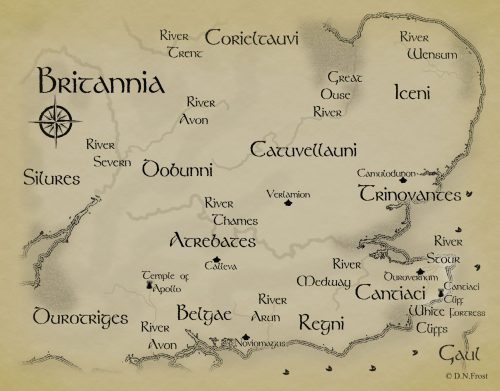
Southeast Britannia Showing Location of Celtic Tribal Kingdoms
March to the Thames
Julius Caesar had to halt his initial advance so his soldiers could repair ships that had been damaged in an overnight storm off the coastline. His army worked day and night for ten days to repair the sea vessels and to drag them on the beach into a fortified encampment. The huge task of protecting the fleet required a defensive line of four to five miles. The loss of time cost Caesar a resounding conquest, as the Britons had time to forget their political differences and to ally under a supreme commander, Cassivellaunus—the ruler of lands bounded by the north bank of the Thames River.
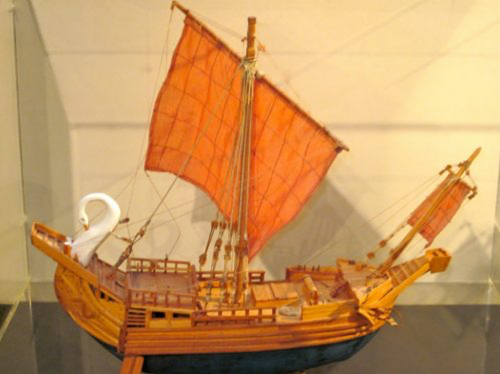
Replica of Ancient Roman Ship
Cassivellaunus had learned not to engage with the Roman army in open battle. He instead resorted to guerrilla tactics to menace the Roman army. Nonetheless, three Roman legions routed his main forces, forcing the Celtic warriors to withdraw to dense woodlands north of the Thames. There, the Britons prepared to resist.
Yet once again, the Roman troops displayed their discipline and training by fording the river in neck-high water. Not willing to risk an open engagement with the enemy, Cassivellaunus disbanded most of his forces and kept only 4000 charioteers to harass the flanks and rear of advancing Romans. He must have been bitterly disappointed that his forces could not even hold the Thames.
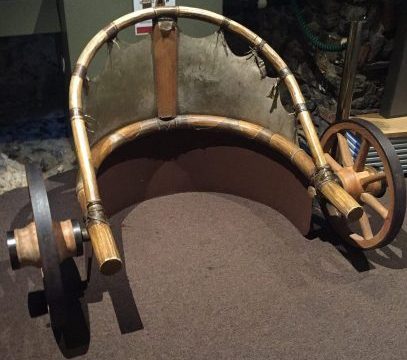
Celtic Chariot Displayed at Colchester Museum
Hidden Weapon
Caesar’s march into hostile territory, separating him from the main supply line, might have appeared to be fool-hardy. However, Mandubracius proved to be a valuable ally when he negotiated with envoys from the Trivovantes tribe to supply the Roman troops with grain and forty hostages in exchange for Caesar’s recognition of the prince’s rightful claim to the throne. Further, the young prince persuaded five other tribes that bordered the kingdom of Cassivellaunus to join him in submitting to Rome. The political implications of these tribal defections to Caesar were dramatic. The capitulating British leaders informed Caesar of the location of Cassivellaunus’ forces in the thick woodlands and marshes. The Roman legions promptly and effectively attacked the enemy warriors that resulted in the slaughter of many Britons.
Final Surrender
In one last desperate attempt, Cassivellaunus ordered Kentish tribes along the coastline to attack the Roman naval encampment to cut off Caesar from Gaul. The Romans were ready for the attack and inflicted several Celtic casualties and captured the leaders.
Cassivellaunus had no other option but to negotiate his surrender to Commius, the king of the Arbetrates tribe from Gaul. As mentioned in a previous post, Caesar had sent Commius as an envoy to persuade the Britons not to resist his first invasion of Britain in 55 BC. However, the British kings held Commius as a prisoner, but they eventually handed him back to Caesar as part of the negotiations in the first invasion. Any plans that Caesar had for staying in Britain had to be abandoned when he learned of serious trouble in Gaul that demanded his attention. He collected several British hostages, levied an annual tribute on the hostile tribes, and ordered Cassivellaunus not to attack either Mandubracius or the Trivovantes.
By the autumn equinox, Caesar’s troops returned to the coastline, where all of the sea vessels had been fully repaired. The ships had to make two voyages to ferry the innumerable hostages, prisoners, and Roman legions back to Gaul. It should be noted that Commius remained Caesar’s loyal client king throughout the Gaulish revolts of 54 BC. In return, Caesar allowed the Atrebates to remain independent and exempt from tax until Commius joined forces with Vercingetorix to defeat Caesar. More will be said about Commius in upcoming posts.
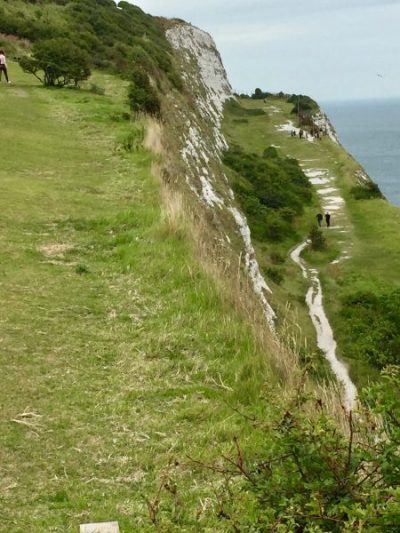
Pathway Along Coastline Near Dover, UK
Conclusions
In both expeditions, Caesar failed to understand his most formidable enemy —the strong tidal currents from the English Channel. The tidal current continued to be an obstacle that the Romans had to be overcome in their invasion eighty years later by Claudius in 43 AD.
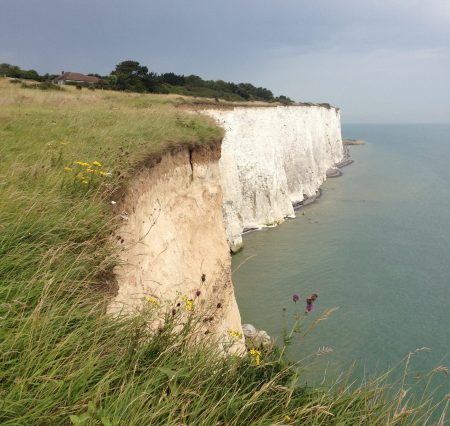
White Cliffs of Dover
(To be continued)
The next series of posts will discuss the role of British hostages in forging alliances from Rome, the subsequent political unrest with emerging anti-Roman tribal leaders, and the cultural differences between Rome and Ancient Britain which precipitated the invasion by Claudius in 43 AD.
References:
Julius Caesar, translated by F. P. Long, 2005. The Conquest of Gaul; United States: Barnes & Noble, Inc.
John Peddie, Conquest: The Roman Invasion of Britain; Reprinted 1997 by St. Martin’s Press, New York.
Graham Webster, The Roman Invasion of Britain; Reprinted 1999 by Routledge, New York.
Christopher Vogler, The Writer’s Journey; 3rd Edition Reprinted by Sheridan Books, Inc., Chelsea, Michigan


Tom
Posted at 20:13h, 09 JuneVery Nice!
Tom
Posted at 20:15h, 09 JuneVery Nice Job! I enjoyed all the history. Keep-up the good work. Tom
tattoo
Posted at 07:54h, 03 JulyThe Borneo tribe believed that everything has spirits in them.
Tattoo kits for sale and Cheap tattoo kits for beginners for tattoo art.
Rates are competitive at these businesses and the tattoo artists are
very talented.
Aquileana
Posted at 00:54h, 10 DecemberGreat historic approach… A very well penned and informative post dear Linnea. Thanks for sharing. Best wishes. Aquileana 🙂
Linnea Tanner
Posted at 02:16h, 10 DecemberThanks, Aquileana, for your comment and your continued support. Glad you enjoyed it. Have a great week!
Best regards,
Linnea